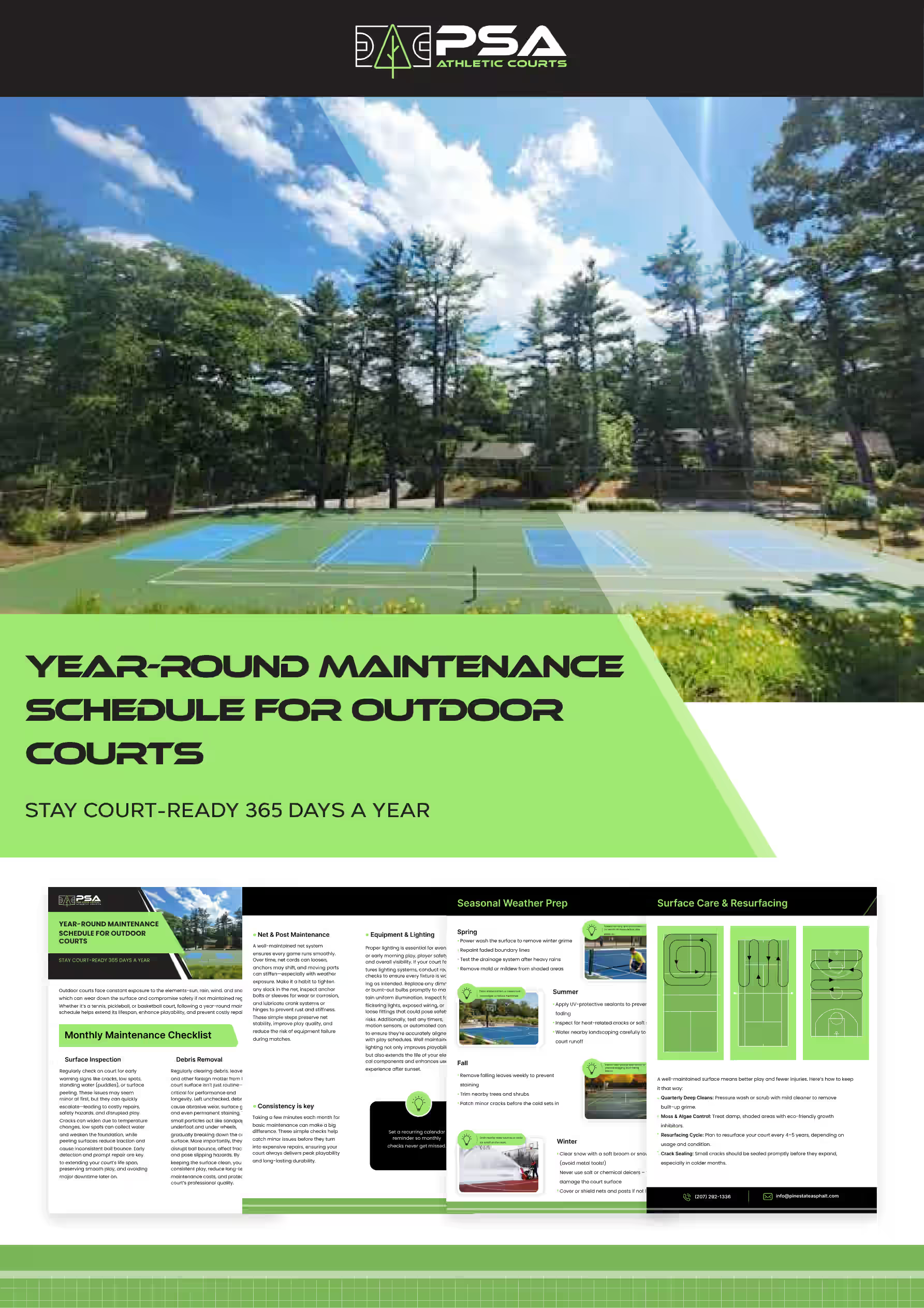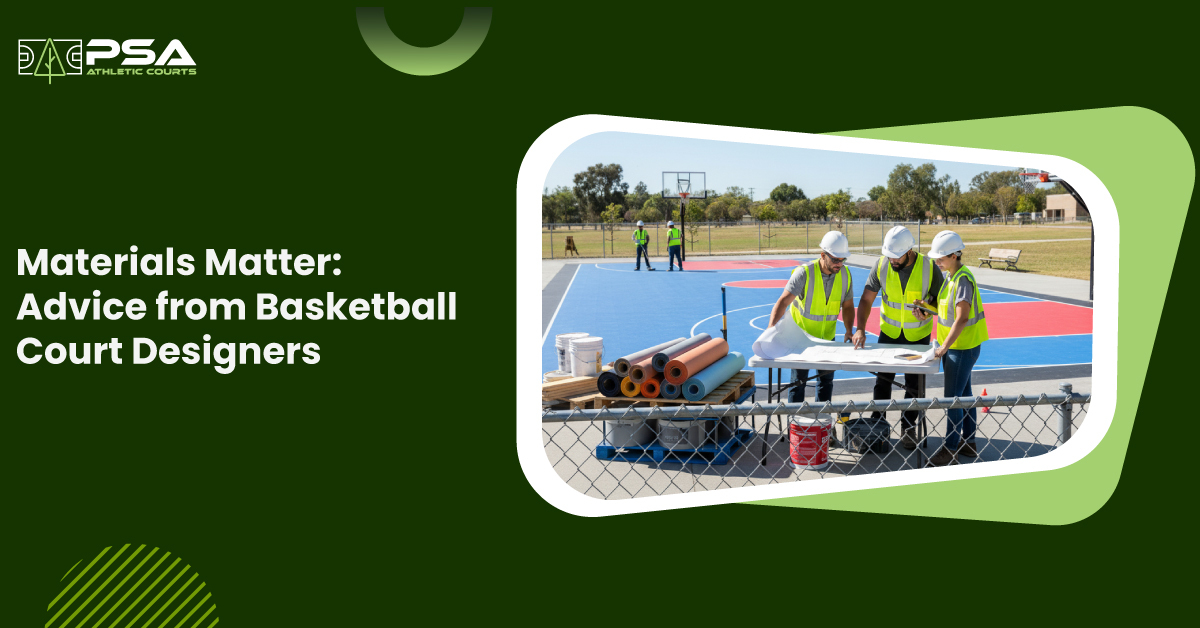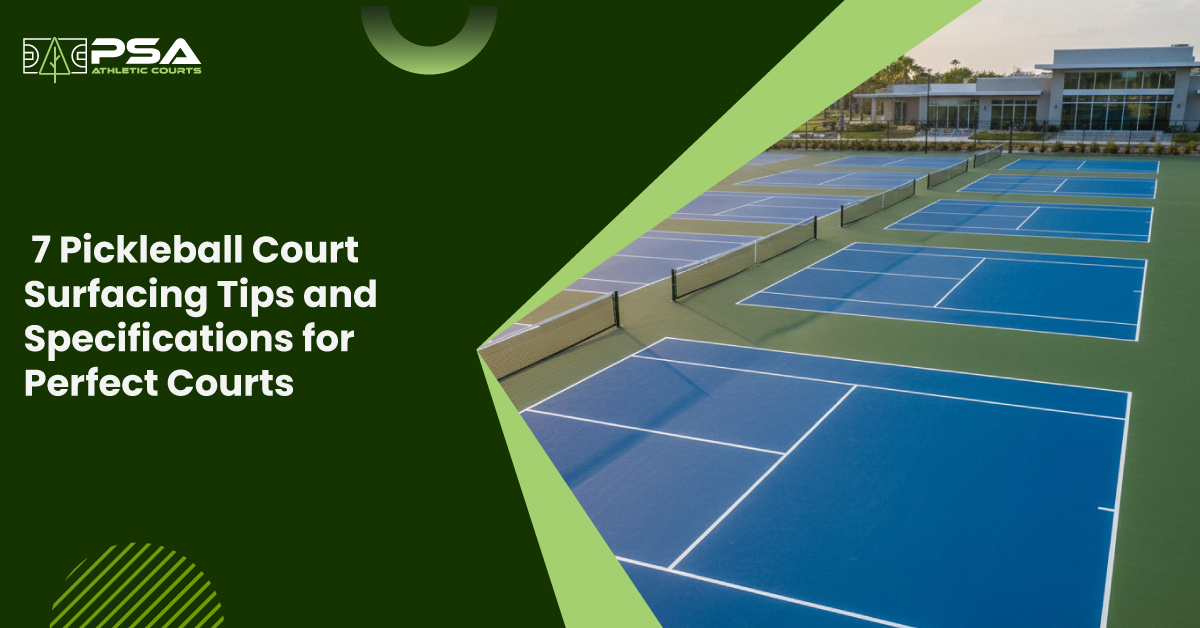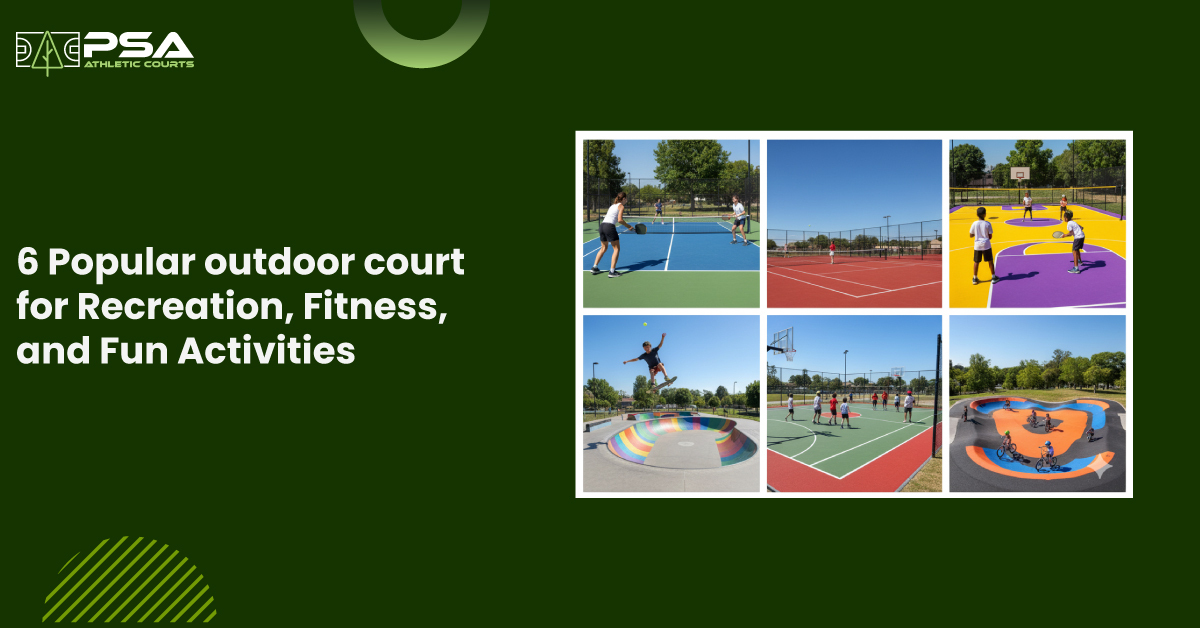From the warmth of polished hardwood that hosts the finest NBA games, to the rugged outdoor courts that serve as battlegrounds for street players, each court tells its own story of passion, performance, and play. And central to all these unforgettable experiences is the court surface.
Ask any seasoned basketball court designer, and they’ll tell you that the right surface can turn a simple game into a memorable experience. If you too are searching for the right material for your court then you’ve come to the right place.
In this surfacing material guide by Pine State Courts, we will dive into the wisdom of professional basketball court designers. We’ll understand why court’s surfacing material matters and how it creates the difference between an unforgettable playing experience and a challenging gameplay.
Importance of Choosing the Right Materials
While designing a basketball court, getting the surface material right is like winning half the battle. The material you choose affects how the court feels, how players move, and how long your investment lasts.
If you are a new court owner or thinking of building a backyard basketball court, here are a few key reasons why the right material matters:
- Player Performance - The right surface material provides a consistent ball bounce, proper grip, and the right level of responsiveness for smooth gameplay.
- Player Safety - With good traction and shock absorption, the right surface reduces the risk of slips, falls, and joint injuries.
- Durability & Longevity - Good quality materials can handle wear and tear over time, extreme weather, and heavy use without warping or cracking.
- Ease of Installation - Some materials are easier and faster to install than others, this saves both time and labor costs.
- Maintenance & Cost - Getting low-maintenance surfaces can save you money and effort in the long run while keeping your court looking great.
Wondering which size is best for your court? Here’s our guide on basketball court dimensions 101 to give you the basic information about NBA vs. FIBA vs. College court dimensions.
Types of Basketball Court Materials

From NBA-famed hardwood courts to street famous asphalt courts, each court is a sacred space for players where they are one with the game. Besides these two materials, there are plenty of other options to choose from.
Wondering which is best suited to your professional court or backyard project? Here’s a quick overview of the court materials to help you decide the same:
Hardwood basketball court
The hardwood surface is best for building an indoor basketball court. The wood primarily used for these courts is hard maple wood which is chosen for its hardness, durability, consistent ball response, and resilience. All of these make it the ideal choice for professional-level play.
These hardwood basketball courts are a common sight for NBA matches and The Olympics. Some collegiate level courts also use a combination of vinyl-wood for their cost effectiveness.
Asphalt basketball court
The asphalt courts are a common sight in street basketball matches, including the famous Rucker Park in New York. These courts are popular for their durability, great traction, and shock absorption.
Their low cost installation is also another reason for their popularity. The surface typically lasts 10–15 years before resurfacing is needed, while the asphalt base can last decades.
Concrete basketball court
Basketball courts made of concrete are common for backyard projects. Although they have a high initial installation cost, they offer excellent durability of 20+ years with regular maintenance.
Its smooth surface offers great consistency which is suited to introduce the game to kids in schools and community parks. It can also be customized to provide an enhanced grip and ensure player safety.
Acrylic basketball court
Acrylic coating is applied to asphalt or concrete surfaces to enhance color, improve traction, and protect against weathering. Cushion systems can be added underneath for extra comfort.
Its shock absorption also reduces the strain on the player's joints. The acrylic basketball courts are suitable for college games and offer a great durability with its easy maintenance.
Future Trends in Basketball Court Materials
Besides these common court surface materials, there is a rising popularity of sustainable and eco-friendly court materials. These future trends in the basketball court materials include:
- Use of a combination of renewable wood and recycled rubber for indoor basketball courts is on the rise. This duo unveils a high-performance court and enhances player comfort.
- Modular tiles and rubber tile flooring is also gaining popularity for its easy, DIY installation. This type of gym flooring adds to the traction and makes the surface safe and durable.
- Use of sensors on the court flooring helps track players’ movements. This provides valuable real-time data for performance analysis by the coaches and helps prevent injuries.
- LED lighting systems are also being incorporated into the court surface. Doing this will effectively highlight specific sport lines on the court, offering dynamic and customizable floor markings.
Cost & Budgeting Insights
Wondering how much all this costs? When it comes to building a basketball court, installation expenses are often one of the biggest factors that shape the final decision. The total cost isn’t the same for every court, for instance an outdoor backyard project can cost between $10,000 to $25,000 because costs vary by size and material. . While an indoor hardwood court can cost around $28,200 to $70,500.
The key factors that determine and influence this cost, include:
- Court Size: A half court will naturally cost less than a full professional-sized court, not just in terms of material cost but also in terms of the labor and maintenance cost.
- Type of Surface Material: Amongst the hardwood, acrylic, modular tiles, or concrete, each option comes with its own price point and long-term upkeep costs.
- Preparing the Foundation: If your site needs leveling, grading, or drainage work before installation, it can also add to the overall cost of the court.
- Customizations: Getting any extra custom features like painted logos, LED lighting, fencing, or cushioned surfaces not only elevate your court’s aesthetics but the budget too.
Expert Advice from Court Designers
Now that you know your options and have a sense of the costs involved, it’s time to match those insights with what matters most. Choosing the right court surface isn’t just a technical decision, it’s about creating a place where the game truly comes to life.
Still unsure which surface is best for you? Here’s what professional basketball court designers at Pine State Courts recommend:
- Asphalt - A low-cost option that’s quick to install. It is ideal for community or recreational spaces. But be prepared for regular resurfacing to keep it in good shape.
- Concrete -Durable but higher upfront cost; holds up well long-term. It however offers minimal shock absorption which can affect the player's comfort.
Acrylic - Offers great traction, low maintenance, and better player safety. It is a popular choice for outdoor courts. - Hardwood - It is the gold standard for professional indoor courts with its high durability and exceptional playing feel. But it comes with a higher installation cost.
- Polymeric Rubber - Offers a cushioned, slip-resistant surface that’s gentle on the joints. It is a premium option with a higher price tag.
- Modular Tiles - It is versatile, easy to install, and a moderately priced option A smart choice for flexible spaces or DIY projects.
Common Court Mistakes to Avoid
Even the best materials can underperform if the basics of construction and maintenance are overlooked. Here are a few common mistakes court designers see time and again that affects the gameplay and court performance:
- Not preparing the ground properly: Before anything else, the groundwork you lay for the court’s installation is important for its performance and long-term durability.
- Skipping Regular Maintenance: Even the most durable surfaces need periodic cleaning, inspection, and touch-ups to remain in their top shape.
- Neglecting Resurfacing Schedules: All courts wear over time, necessitating regular basketball court resurfacing to maintain their look and performance.
- Ignoring Weather Conditions: Not accounting for heat, rain, or frost during basketball court installation and material selection can shorten your court’s lifespan.
- Not hiring the an experienced basketball court builder: Look for an experienced basketball court builder that not only designs and installs the court but also offers maintenance and resurfacing support for court durability.
Takeaway
Building a basketball court is more than just pouring concrete or laying tiles, it’s about creating a space where the game feels right and where every dribble and jump counts. The material you choose thus shapes everything including how the game plays, how safe it is for players, and how long the court lasts.
By understanding your options, budgeting wisely, and learning from expert designers, you can choose a surface that fits your goals. At Pine State Courts, we deliver each court with lasting durability and great playability, be it a professional-grade asphalt court or a simple, customized backyard setup. Connect with us for more information.
Frequently Asked Questions
1. What is better for a basketball court, asphalt or concrete?
Amongst asphalt and concrete, deciding which material is better depends on your budget and level of play. For durable, backyard projects with a high budget, choose concrete but for a budget friendly, flexible playing surface asphalt is a better option.
2. What material is an NBA court?
An NBA court is an indoor court made of hardwood maple. This wooden surface is chosen for its durability, traction, and flexibility for a professional play.
3. Does the climate affect material choice?
Yes, climate greatly affects the material choice for a basketball court. Some materials like acrylic, polyurethane, and rubber are resilient against temperature fluctuations, humidity, and rain. While others like asphalt and concrete can crack or soften in extreme heat and cold. Ensuring proper drainage and applying UV-resistant coatings helps with the durability of the court.
4. How much does resurfacing a basketball court cost?
The basketball court resurfacing cost depends on factors like the extent of repairs required, the size and surface material of the court. It can range anywhere between $3500 to $15000, for a hardwood court this cost can go up to $25000.
5. Are modular tiles worth the investment?
For an outdoor basketball court project with requirements like good traction, easy installation, and maintenance, modular tiles are a great investment. They also offer portability and customization benefits.
DOWNLOAD OuR
FREE GUIDE
Stay on top of your court maintenance all year. Whether it's rain, snow, summer, or fall - we've got you covered with this complete guide.
Get a complete month-by-month breakdown to keep your outdoor courts safe, clean, and game-ready.
